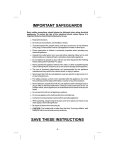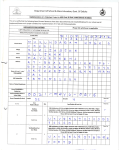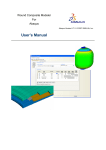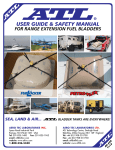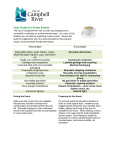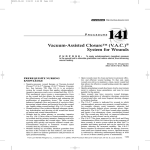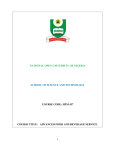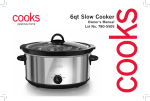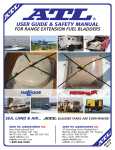Download Dining Room Service Outline
Transcript
Dining Room Service Manual Outline Created by The HCCM Group This outline is used to create a fully expanded dining room service manual based on your unique requirements. It can be modified for a startup, freestanding restaurant, country club, city club, or hotel dining room. The HCCM Group offers this Dining Room Service Outline with its compliments. Contact us at [email protected] for additional information or services. Dining Room Service Manual Outline Table of Contents Beginning your shift ............................................................4 Ending your shift..................................................................4 Appearance & Atmosphere ..................................................4 Dining Room/Lounge ..........................................................4 Lounge .................................................................................5 Grill ................................................................................. 5 Table Setting ........................................................................5 Linen ............................................................................... 5 China, Glass & Silverware .............................................. 6 Napkins ........................................................................... 6 Chairs .............................................................................. 7 Handling China, Glass & Silver...........................................7 China ............................................................................... 7 Glassware ........................................................................ 7 Silverware ....................................................................... 8 How to carry trays................................................................8 Cocktail Trays ................................................................. 8 Tray Jacks ....................................................................... 8 Approaching A Table ...........................................................9 Serving Beverages .............................................................10 Presenting Specials ............................................................10 Taking Orders ....................................................................11 Placing Orders ....................................................................12 Delivering Food…………………………………………. 13 Salads/Soups….…………………………………………. 13 Clearing Soups and Salads………………………………. 13 Delivering Entrees…........………………………………. 14 Clearing Entrees…...……..……………………………… 14 Presenting Desserts..……..……………………………….14 Presenting Checks....……..……………………………….15 Closing Checks…....……..………………………………. 15 Bar Pouring Guidelines.……………………………….16-18 2 Dining Room Service Manual Outline THIS PAGE LEFT INTENTIONALLY BLANK 3 Dining Room Service Manual Outline Dining Room Service Standards of Operation Beginning your shift When beginning your shift, it is important to understand the day’s events before starting your opening side work. After clocking in, check the banquet sheets for both today’s and tomorrow’s events to get an understanding of what needs to be done during the day, and what set-up needs to be done at the end of the day. Be sure to check in with your shift supervisor before starting your work. Opening side work lists are posted in each dining room service area of the club. Ending your shift Unless otherwise specified, all next day’s events are to be set-up the previous day. After completing all assigned closing side work, check with your supervisor to see what additional set-up needs to be done for the next day’s events. If no events are scheduled, check out with your supervisor to ensure all side work has been completed. Closing side work lists are posted in each department of the club. Appearance & Atmosphere It is the staff’s responsibility to ensure that the appearance and atmosphere of each particular dining area meets our standards. Take a few minutes at the beginning of each shift to check the following. Dining Room/Lounge -Music set to ___ for lunch – Piano on for dinner. -Blinds are all in correct position. -Tables are straight in line. 4 Dining Room Service Manual Outline -Tablecloths are clean -No stray chairs are left on the floor. -Lights are turned off (Lunch) or dimmed properly (Dinner) -Fireplace is turned on (Dinner) Lounge -Tables are straight -Tables are wiped clean -Condiments and napkins are straight -Bar is wiped clean -Lights are turned off (Lunch) or dimmed properly (Dinner) -Blinds are in correct position -Heaters are turned on at night -Fireplace is turned on at dusk -Card Room -No stray papers, magazines or flyers on tables Grill -All tables are wiped clean -Sugar Caddies, salt and peppers are filled -Counters are wiped clean -Salad Bar is clean and fully stocked -Condiment table is fully stocked and clean Table Setting Linen 1. Make sure tablecloth is free from stains or holes. All stained tablecloths should be given to supervisor in order to obtain credit for the dirty cloth. 2. Burgundy linens are used as underliners and remain throughout shift (Unless stained through to underliner). Place underliner “Face up” with hems and tags face down, on the center of the table. Cloth should be squared all the way around the 5 Dining Room Service Manual Outline table. Use 72” cloth for square tables and 85” for round tables. 3. Ivory linens are used as overlays, creating a “Diamond” shape over the underliner. Ivory cloth should also be centered and “Face up”. China, Glass & Silverware 1. All silverware should be placed ½” above the edge of the table. 2. Fork and knife should be placed on the inside of the arms of the chair with enough space to fit an entrée plate in between. 3. Forks, knives and spoons should be placed as close together as possible without actually touching. All silverware should be set straight on the table. 4. Bread plates should be set just to the left of the salad fork 1” above the edge. For round tables, bread plates are placed ½” above salad forks and centered. 5. Butter knifes are to be place at the top of the bread plate with knife pointing down and to the left. 6. Water glasses are placed on the inside of the knife with enough room for an entrée plate. Any additional glassware should be placed moving diagonally above and to the outside. 7. When setting coffee cups at the table, place cup and saucer to the right of the spoon 1” above the edge. Coffee cup handles are to be set at 4:00. Napkins 1. Napkins are to be placed directly in front of the chair 1” above the edge. 2. Fan folds are to be used for dinner, silverware rolls are used for the lounge. 6 Dining Room Service Manual Outline Chairs 1. Are to be checked for crumbs and spills before resetting table. 2. Should be placed straight in front of setting – chairs should just touch the tablecloth without going underneath table. Centerpieces/Condiments 1. Mirrors and flowers should be placed directly in the center of the table. 2. Candles should be placed in front of flowers – facing the dining room entrance. 3. Salt and peppers should be placed behind flowers. 4. With empty settings, centerpieces should be moved towards the edge of the empty setting to create more room for the table. Handling China, Glass & Silver China *Plates are to be carried out on a lined tray *Plates are only to be touched at the edge or the bottom – do not touch food contact surface *When handling hot plates, use a hot holder or linen to handle plate and always warn guests that plates are hot Glassware *Glassware is to be carried on a tray *Glassware is to be handled only by the bottom half – do not touch mouth contact surface 7 Dining Room Service Manual Outline *Wine glasses are to be handled by the stem – be sure glass is polished before using *Whenever possible, refill waters, coffee and sodas on the table – do not lift glassware unless refilling is impossible *Never pick up glassware by putting fingers inside the glass Silverware *Always carry silverware to a table on a lined tray or in a napkin *When handing silverware to a guest, let the guest grab the stem while covering the top with your napkin *When removing extra silverware from a table, grab silver by the base and make as little noise as possible – return the extra silver to the appropriate station. Move condiments to the empty part of the table. How to carry trays Cocktail Trays *When loading tray, distribute all weight evenly and as close to center as possible *When serving to a table without a cloth – load appropriate amount of cocktail napkins *Carry tray above shoulder with wrist bent back *When unloading drinks – keep weight distributed evenly on tray by removing glasses from the edges first Tray Jacks *Once plates have been loaded onto tray, place appropriate condiments in the middle of the tray (Hot & Cold covers are to be used for O’Meara Lounge). 8 Dining Room Service Manual Outline *Bend at the knees and while keeping back straight, balance the tray between hand and shoulder. *Lift tray keeping back straight and use free hand or foot to open kitchen doors. *Always use “Hot Food” or “Behind You” when approaching others. *Grab tray jack stand and place near table – away from traffic areas. *Bend at knees and place tray on stand – do not turn at the waist while carrying trays Seating Members (Dining Room) *Greet members by last name – if busy, acknowledge members and let them know you will be right with them *If necessary, check with host to determine seating arrangements *Write down member names and number on reservation sheet *Pull out chairs for ladies and offer to help with any coats, bags, etc. *If small children are present, offer boosters or high chairs *Lunch – hand out menus to each guest closed and from the left *Dinner – hand wine list to the member or head of the table *If server is busy, offer to take a cocktail order, otherwise let them know “_____ will be serving you today (tonight), he/she will be with you in a moment. Enjoy your dinner.” *Notify server that a new table has arrived Approaching A Table *Before approaching your table, be sure that you know the member’s last name, and if possible, names of any guests which are at the table. If you do not know the last name, 9 Dining Room Service Manual Outline ask for the member number, and use the membership cross-reference list to determine the last name. All checks should be rung in with the last name of the member. *Approach your table with “Good afternoon/evening Mr/Mrs. Jones.” If your table does not know you, introduce yourself by saying “My name is ___ and I will be serving you today/this evening.” *Always start your table with a drink order by suggesting something specific. “May I interest anyone in a glass of wine or a martini from the bar to start?” *After drink orders are taken, let the table know you will be back in a moment with their drinks. Serving Beverages *Serve drinks from the right side of the guest – handling glassware by the bottom. Small children and ladies are served first, followed by the men. *For dinner tables, after drinks have been served, present menus to each guest – closed and from the left side. Offer children’s menus for small children. Presenting Specials *After menus have been given and drinks have been served, let the table know about the specials of the day and any other information they should know about the menu. Lunch *Fish of the day *Soup of the day *Egg special *Tacos of the day 10 Dining Room Service Manual Outline Dinner *Soup of the day *Vegetables of the day *Featured items or specials (if any) *Any 86ed items (if any) *If the table is not familiar with the menu, explain the following: -All entrees are accompanied with choice of soup, house or Caesar salad. (Kids menu items excepted) -Upgrade salads may be substituted for $2.50 *After specials have been presented, ask the table if they would like to start with an appetizer – give specific suggestions. “While you look over the menu, would anyone like to start with an order of Crab Cakes or our Bruschetta Trio?” Taking Orders *Once the table has decided on what to order, (Menus will usually be closed) proceed to the table and ask if everyone has decided. *Starting with small children and ladies, take order and repeat order to the guest to ensure that there will be no confusion. It is important to repeat the name of the entrée as it appears on the menu, as many items may sound similar. *Make sure that the order corresponds with the proper seat number on your server pad. *Collect menus after each guest has ordered. 11 Dining Room Service Manual Outline Placing Orders Lunch *Any starters – soup or salad, should be rung in first. The server is responsible for timing when the entrees will be entered. *Always use member names on your ticket so that food runners may deliver your food if you are busy. *Always double check your order to ensure that nothing was missed. Dinner *Any appetizer, that is a separate course, should be rung in first. Wait to ring in entrees and salads until the appetizer is ready. *Any appetizer which is to be delivered with the salad or entrée course should be entered with salads and entrees and noted by using “As salad” or “As Entrée”. *Salad course and Entrée courses are to be entered together. *When taking children’s orders, ask the adults if they would like to have the children’s entrees brought out with the salad course. *Use correct Table and Seat numbers to ensure food is delivered properly (If the table number or seat numbers appear awkward or different – notify your back waiter). *Double check your order before sending to the kitchen. Cocktails 12 Dining Room Service Manual Outline *Always use proper preps with cocktails such as “Dry” or “Neat” *The proper way to order a Double is to ring the liquor twice and prep as “Double”. *Always use the “Up” and “Rocks” keys where appropriate. *Always use the “Don’t Make” key if your drink has already been made. Delivering Food *Food is to be delivered from the left side with the left hand when possible. *Young children are to be served first, followed by ladies, and finally, the gentlemen. *For tables of 9 or more, deliver food from one end to another to speed service up. *Always use the name of the entrée or salad when delivering to ensure the correct food is being delivered. *Carry all appropriate condiments on the tray to save time. *Before leaving the table, ask if there is anything else the table would like, and if not, tell the table, “Please enjoy your meals” before leaving. *Deliver food according to seat numbers – do not “Auction” food. Salads/Soups 1. Before salads/soups are delivered, be sure that any appetizers are cleared. 2. Set tray on jack stand away from high traffic areas next to table. 3. Replace starter plate with bread basket and butter. 4. After serving soup and salad course, offer freshly ground pepper. 13 Dining Room Service Manual Outline Clearing soups and salads 1. 2. 3. 4. 5. Always use a tray and tray jack to clear plates. Ask guests if they have finished before clearing plates. Clear plates from the right side with right hand. Clear all salad dressings, soup spoons and salad forks. Use crumb sweeper to remove crumbs from tablecloth. Delivering Entrees 1. Be sure that table is cleared from first course before delivering entrees. 2. If any tableside presentation is needed – do so on the tray before serving. 3. Warn guests that plates are hot – use a hot holder to deliver hot plates. 4. Always place the protein (or main part of plate) at 6:00 – directly in front of guest 5. After delivering entrees, offer appropriate condiments. 6. If anything is missing from the table, make that your first priority – the guests may not be able to eat until the problem is fixed. Clearing Entrees 1. 2. 3. 4. Always use a tray and tray jack to clear plates. Ask guests if they have finished before clearing. Clear plates from the right side with the right hand. Clear all silverware, condiments, bread, etc. – the only things that should be left on the table are the coffee spoon and any beverages the guests may be drinking. 5. Use crumb sweep to remove any crumbs from tablecloth. Presenting Dessert Tray 14 Dining Room Service Manual Outline 1. After plates have been cleared, the dessert tray or cart should be brought to the table, along with dessert menus. 2. After explaining each item, offer alternatives such as fresh seasonal berries. 3. Offer coffee, decaf or after dinner drinks using specific suggestions. Presenting Coffees and Desserts 1. Forks or spoons should be placed on table before dessert arrives along with extra plates for shared desserts. 2. Desserts will be prepared in pastry station and must be delivered by the server when the dessert is ready. 3. Use doilies for decaf coffees – there should be no need to ask “Regular or Decaf” when refills are offered. 4. Make sure creamers and sugars accompany coffees. 5. Coffee and water refills are to be poured on the table – do not lift glass. Use a napkin for a shield in case of spills. Presenting Checks 1. Once your table has finished dessert course, offer refills on coffee and/or drinks before check is presented. 2. Check should be split so that each member has his/her own check for the items that he/she and guests ordered. If unsure as to how the check should be split, check with your supervisor. Once check has been prepared, drop check along with a pencil to sign and truffles from the pastry chef (Dinner Only). Thank the guests when presenting check Use last names when possible. 15 Dining Room Service Manual Outline Closing Checks 1. 2. a. b. c. All checks must be closed before ending your shift. Service charges are added as follows: Equity Members – no service charge Social/Tennis Members – 15% service charge Reciprocals/ Other Clubs – 20% service charge -There is a current list of member numbers with service charges posted at each service station 3. Gratuities are added on the check and recorded in the tip book. 4. A service report is to be rung, and all checks must be dropped before ending your shift. Bar – Pouring Guidelines 1. All servers and bartenders are to ensure that each member receives a consistent pour with all wines and spirits. Over pouring or under pouring will not be accepted, and may warrant disciplinary action. a. Standard pour is 2 oz. b. Rocks pour is 3 oz. ($1.00 Charge added for rocks drinks) c. “Up” drinks are 3.5 oz. ($1.50 charge added for up drinks) d. Wine glass pour is 6 oz. (Whites – ¾ full / Reds 2/3 full) The appropriate preps must be added to ensure proper pricing for Rocks and Up Drinks. Bartenders will automatically use appropriate pour. 2. Banquet Pours will be in effect for non-member functions: a. Banquet pour is 1.25 oz b. There are no separate rocks or up pours for banquets c. Wine glass pour is 5 oz. Alcohol – Over Consumption Policy 16 Dining Room Service Manual Outline NOTE: Minimum 1 manager will be certified in TIPS or a state accepted & recognized alcohol awareness program. Managers and staff will always take all reasonable steps to prevent over consumption and prevent our members/guests from driving while under the influence of alcohol. Because we are concerned for the safety of our guests and the surrounding communities of the club, the following steps will be taken: 1. It is the server/bartender’s responsibility to ensure that a guest does not over consume alcohol. Third party liability laws can hold the club or server responsible for accidents caused from excessive drinking at the club. 2. It is the server/bartender’s responsibility to card anyone who appears to be under 30 years of age. Acceptable forms of ID include: a. A valid driver’s license b. A valid military identification c. State ID or Passport -Examine all information on the ID including birth date, height, weight, sex, inc. -If there is a doubt as to the legitimacy of the ID, notify a manager at once. -Do not allow a guest to buy drinks for a group without checking ID’s of all guests in the group. 3. Notify a manager immediately if a particular guest or group is consuming heavily and you are concerned there is a potential for over consumption. Signs of intoxication include: a. Slurred speech b. Excessively loud behavior 17 Dining Room Service Manual Outline c. Loss of coordination -If unsure of level of intoxication, engage in conversation to determine mental alertness and speech. 4. Do not serve a guest who enters the establishment appearing intoxicated. When dealing with intoxicated guests, offer snacks or non-alcoholic drinks as an alternative to alcohol. If the guests still insists on ordering a drink, notify a manager at once. 5. The bartender/server may offer to call a cab for guests appearing intoxicated. 18 Dining Room Service Manual Outline I have read, understand, and have received a copy of this Dining Room Service Manual SOP Print Name______________________________ Signature________________________________ Date____________________________________ Manager’s Acknowledgement_________________________ Date____________________________________ 19 Dining Room Service Manual Outline THIS PAGE INTENTIONALLY LEFT BLANK 20





















